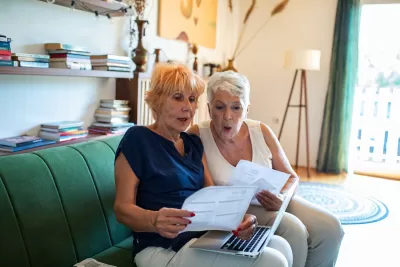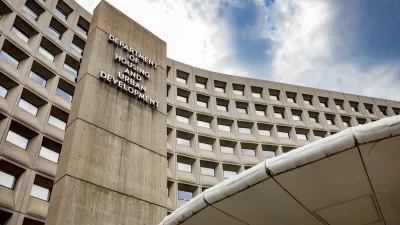Lessons for building affirming, inclusive, and trauma-informed housing developments for older LGBTQ+ adults.

LGBTQ+ people face disproportionate rates of discrimination and poverty, including a shared history of community trauma involving both interpersonal and systemic discrimination. This has impacted LGBTQ+ elders in a myriad of ways around disparate health outcomes and unequal access, especially when it comes to housing.
Housing challenges faced by LGBTQ+ elders
LGBTQ+ elders are disproportionately affected by housing discrimination and housing insecurity when compared to non-LGBTQ+ older people. Per a 2023 LGBTQ+ Real Estate Report, 29 percent of LGBTQ+ people experienced housing discrimination or harassment in a housing setting in the past year. A separate report from the Equal Rights Center revealed that 48 percent of older people applying for elder housing were subjected to discrimination.
In places that have less public infrastructure or public support systems, the total lack of housing security impacts LGBTQ+ older adults in compounded ways when they age. This can create a sense of isolation, which leads to rapid physical and mental health decline. With the number of LGBTQ+ adults 50 and older expected to reach seven million by 2030 and affordable housing in short supply, innovative solutions are necessary to fill these gaps.
Developing affordable LGBTQ-affirming housing
One way to address the root of these challenges is through the development of safe, LGBTQ+-affirming, affordable housing. LGBTQ+-affirming housing simply means housing that provides a welcoming environment of community, peers, and allies, often including voluntary culturally competent services for LGBTQ+ elders.
A decade ago, SAGE began actively exploring an LGBTQ+ elder housing model. We collaborated with developers to create two of the first LGBTQ+-welcoming elder housing developments: Stonewall House and Crotona Pride House. The developers led all aspects of the development process, and SAGE provided direction on ensuring the housing was LGBTQ+-affirming. Here’s what we learned through the process:
- A vital lesson is to involve community members in the desired development neighborhood well before the development process begins. The first step is getting buy-in from the community and political leaders. Buy-in simply means supporting and believing in an idea or concept. Be methodical about documenting outreach attempts for transparency, ensuring a solid outreach strategy, and reporting to the city and elected officials.
- When creating LGBTQ+-affirming housing, partnerships with developers, community members and organizations, public agencies, elected officials, and social services providers are vital. Partners should be selected based on the mission, community need, and commitment to stabilizing LGBTQ+ elders in their housing. All partners must agree on the residence's vision, process, staffing, and culture.
- Securing capital for these projects requires creativity, flexibility, and persistence. Should any gaps exist, engage in fundraising campaigns focused on government sources or private foundations. For Stonewall House and Crotona Pride House, we worked closely with New York State and City elected officials to secure significant financial support from the New York City Council, as well as with other funders like Harry and Jeanette Weinberg Foundation, New York State Homes and Community Renewal (HCR), and HPD’S Senior Affordable Rental Program (SARA).
- It is key to consider architectural designs specific to LGBTQ+-specific aging. This includes choosing an architect familiar with trauma-informed design, making spaces less institutional, considering cognitive health needs in long-term design planning, geographic location, and more. Checklists to consider when creating these spaces can be found in the National Housing Institute Toolkit.
- Develop a plan to reach the people who will benefit the most from this housing and meet them where they are. Map out a detailed and structured outreach/marketing strategy from the beginning through the lease-up process. Remember to include a budget for designing assets, posting ads, and printing materials.
Fixing supply and demand
While developing new LGBTQ+-affirming housing is important, supply and demand must be in sync. Construction alone on new developments can take 18-24 months, which leaves many LGBTQ+ older people disproportionately affected by housing insecurity.
Fortunately, housing developments can take many steps to ensure their current properties are affirming, safe, and inclusive of LGBQ+ elders. Here are some ways to increase inclusivity for the LGBTQ+ community:
- Audit all internal documentation and reevaluate procedures and policies regarding the treatment of discriminatory instances within the organization. Updating language to include the LGBTQ+ community in your anti-discriminatory or other policies and upholding the standards established is a vital step toward creating an inclusive environment for all.
- Update marketing, messaging, and relevant paperwork to reflect your inclusivity and diversity commitments. This includes minimizing gender-specific terms and using words like “partner” in conversations and intake forms.
- Since the majority of states and territories lack explicit laws to prevent LGBTQ+ housing discrimination, advocate for policies that ensure LGBTQ+ elders across the country can access welcoming housing.
- Engage consultants with a proven track record of pioneering organizational inclusivity for the aging LGBTQ+ community to provide tools and training for each member or employee to ensure everyone is equally educated and accountable for the same standards.
- Make your mission known to all staff members, stakeholders, clients, residents, etc. Your organizational commitment to a more equitable and welcoming environment for aging LGBTQ+ individuals must be followed through at all levels in every sector.
Homes should be a haven
Homes should be havens, especially as we age. They should be safe enough for LGBTQ+ people to live as their authentic selves. Instead, LGBTQ+ elders face many challenges. Housing developers can change this by taking the necessary steps to ensure that the LGBTQ+ community can find housing that is accepting of their identities so they no longer have to live in fear.
Sydney Kopp-Richardson is Director of National LGBTQ+ Elder Housing Initiatives for SAGE (Services and Advocacy for GLBT Elders).

Maui's Vacation Rental Debate Turns Ugly
Verbal attacks, misinformation campaigns and fistfights plague a high-stakes debate to convert thousands of vacation rentals into long-term housing.

Planetizen Federal Action Tracker
A weekly monitor of how Trump’s orders and actions are impacting planners and planning in America.

In Urban Planning, AI Prompting Could be the New Design Thinking
Creativity has long been key to great urban design. What if we see AI as our new creative partner?

Pedestrian Deaths Drop, Remain Twice as High as in 2009
Fatalities declined by 4 percent in 2024, but the U.S. is still nowhere close to ‘Vision Zero.’

King County Supportive Housing Program Offers Hope for Unhoused Residents
The county is taking a ‘Housing First’ approach that prioritizes getting people into housing, then offering wraparound supportive services.

Researchers Use AI to Get Clearer Picture of US Housing
Analysts are using artificial intelligence to supercharge their research by allowing them to comb through data faster. Though these AI tools can be error prone, they save time and housing researchers are optimistic about the future.
Urban Design for Planners 1: Software Tools
This six-course series explores essential urban design concepts using open source software and equips planners with the tools they need to participate fully in the urban design process.
Planning for Universal Design
Learn the tools for implementing Universal Design in planning regulations.
planning NEXT
Appalachian Highlands Housing Partners
Mpact (founded as Rail~Volution)
City of Camden Redevelopment Agency
City of Astoria
City of Portland
City of Laramie





























